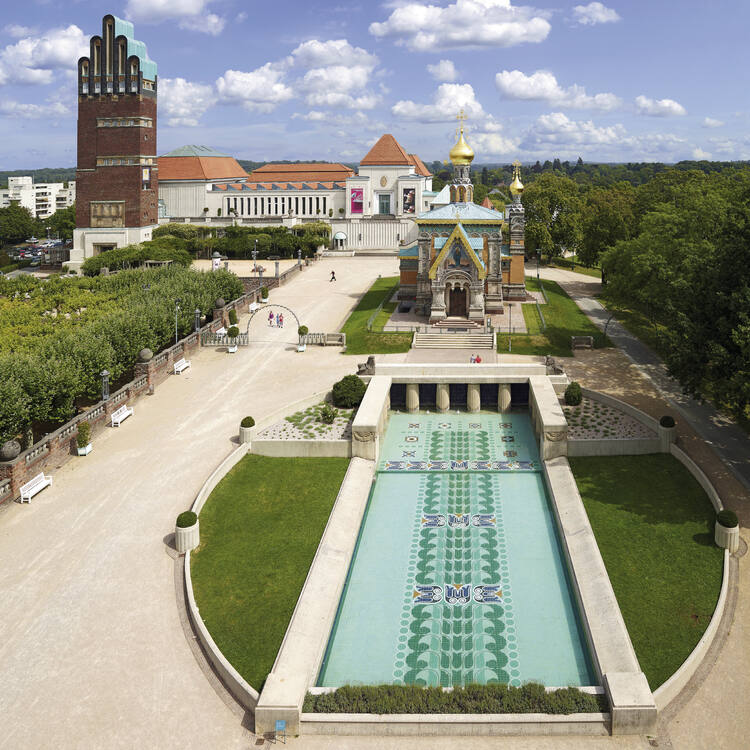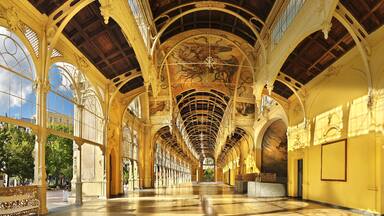Mathildenhöhe Darmstadt
Mathildenhöhe Darmstadt
Description is available under license CC-BY-SA IGO 3.0
La Mathildenhöhe à Darmstadt
La colonie d’artistes de Darmstadt, située dans la Mathildenhöhe, point culminant de la ville de Darmstadt, dans le centre-ouest de l’Allemagne, fut fondée en 1897 par le grand-duc de Hesse, Ernst Ludwig, en tant que centre des nouveaux mouvements réformistes alors émergents dans les domaines de l’architecture, des arts et de l’artisanat. Les bâtiments de la colonie sont l’œuvre des artistes qui en furent les membres, servant de cadres de vie et de travail expérimentaux du début du modernisme. La colonie s’est agrandie au cours des expositions internationales successives de 1901, 1904, 1908 et 1914. Aujourd’hui, elle offre un témoignage des débuts de l’architecture, de l’urbanisme et de l’aménagement paysager modernes, tous inspirés par le mouvement Arts and Crafts et la Sécession viennoise. Le bien en série comprend 23 composantes, dont la Tour matrimoniale (1908), le hall d’exposition (1908), le bosquet de platanes (1833, 1904-14), la chapelle russe Sainte-Marie-Madeleine (1897-99), le bassin du Lys, le mémorial de Gottfried Schwab (1905), la pergola et le jardin (1914), le pavillon de jardin « Temple du Cygne » (1914), la fontaine Ernst Ludwig, ainsi que les 13 maisons et ateliers d’artistes qui furent construits pour la colonie d’artistes de Darmstadt et pour les expositions internationales. Un groupe de trois maisons construites pour l’exposition de 1904 constitue une composante supplémentaire.
Description is available under license CC-BY-SA IGO 3.0
مرتفع ماتيلدنهوة في درامشتات
source: UNESCO/CPE
Description is available under license CC-BY-SA IGO 3.0
达姆施塔特的玛蒂尔德高地
source: UNESCO/CPE
Description is available under license CC-BY-SA IGO 3.0
Матильденхёэ, Дармштадт
source: UNESCO/CPE
Description is available under license CC-BY-SA IGO 3.0
La Mathildenhöhe de Darmstadt
source: UNESCO/CPE
Description is available under license CC-BY-SA IGO 3.0
Outstanding Universal Value
Brief synthesis
Mathildenhöhe Darmstadt is an outstanding early-twentieth-century ensemble of experimental buildings and designed landscapes that represents a prototype of Modernism. The place of residence and exhibition grounds of an artists’ colony – a forerunner of permanent international building exhibitions – takes its name from a hill above the City of Darmstadt, in the State of Hesse, Germany. The ensemble consists of works of members of the influential Darmstadt Artists’ Colony who contributed to four internationally acclaimed building exhibitions on the Mathildenhöhe in the years 1901, 1904, 1908, and 1914. Crowning the hill of the Mathildenhöhe is the centrepiece of the ensemble, the iconic Wedding Tower with its distinctive shape, like an up-raised hand, and its two wrap-around strips of small windows. Adjoining is the massive Exhibition Hall, described at the time as an “acropolis” and a “city crown”. The enigmatic Plane Tree Grove, rectangular in plan, extends to the front and adds another dimension, its many sculptural works and inscriptions shaping a place of cyclical nature and universal culture and spirituality. Parallel to the grove is an axis created by the Russian Chapel and the Lily Basin. Complementing this to the south, east and west are studio buildings and an architecturally diverse range of experimental houses set in designed generous urban open space with parks and pavilions, roads and pathways. The ensemble presents a radical synthesis of architecture, design and art, merged with exemplary, high-quality and aesthetically pleasing living and working environments created in the spirit of modern humanism. This pioneering vision was inspired by international artistic and social reform movements of the nineteenth century and initiated by the progressive and commercially minded Grand Duke of Hesse. It was realised by now renowned architects such as Joseph Maria Olbrich and Peter Behrens in the form of a permanent “Gesamtkunstwerk”, a total artwork that is seminal in the history of architecture. Today, Mathildenhöhe Darmstadt provides a compact and exceptional testimony to the emergence of modernist architecture, urban planning and landscape design, with distinct influences from the Arts and Crafts movement and the Vienna Secession, through to examples of Art Nouveau that, with its influences on the Deutsche Werkbund and the Bauhaus, led to the International Style of twentieth-century Modernism.
Criterion (ii): Mathildenhöhe Darmstadt is a prototype of Modernism that provides compact and exceptional testimony to the emergence of twentieth-century modernist architecture and urban landscape design; and of the avant-garde processes by which this happened. Its epochal functional and aesthetic quality reveals a vibrant era of artistic and social reform and embodies a crucial international interchange in the development of architecture and design, urban planning, landscape design and modern exhibition culture. It is a holistic symbol of early Modernism. Four pioneering and internationally acclaimed building exhibitions were held between 1901 and 1914. The innovative permanency of the exhibitions gave form to the Mathildenhöhe, and all exhibits were developed in collaboration with companies from both Germany and abroad. For the very first time as part of an exhibition, modern living and working environments were presented that consisted of permanent homes open to the public during the exhibitions. Mathildenhöhe Darmstadt developed as a semi-utopian community which became a focal point of the relevant trends of early Modernism and a fundamental influence on numerous international building exhibitions in the twentieth and twenty-first centuries.
Criterion (iv): Mathildenhöhe Darmstadt is an exceptional ensemble of architectural elements in a designed landscape, and it represents a prototype of Modernism that documents the emergence of twentieth-century modernist architecture and urban landscape design. It is seminal in the history of architecture. Construction took place between 1899 and 1914, during an era of radical experimentation that characterises the revolutionary age of Modernism. The radical synthesis of architecture, design and art includes experimental exhibition buildings that feature progressive architecture, ambitious designed urban landscapes, contemporary spatial art, and innovative artists’ houses and studio buildings.
Integrity
Mathildenhöhe Darmstadt has sustained its significance with time: the property is of an adequate size and wholeness to contain all attributes that are necessary to convey its Outstanding Universal Value. The property illustrates clearly its functional integrity and pattern of spatial organisation: in particular, the Wedding Tower (as the highest elevation of the ensemble’s silhouette), the Exhibition Hall, the Ernst Ludwig House, the Studio Building (1914), together with the many artists’ houses. These are complemented by the Plane Tree Grove, the fountains and sculptures, as well as the paths in the designed landscape. Mathildenhöhe Darmstadt retains its structural, functional, and visual integrity, even though some elements of the site were carefully restored after suffering damage in the Second World War. It is in a good overall state of conservation and does not suffer from adverse effects of development or neglect. The impact of any potential deterioration processes is strictly controlled.
Authenticity
Mathildenhöhe Darmstadt conveys its significance over time through its authentic location and setting together with a combination of attributes and elements that are genuine, credible and truthful. The essential ensemble of architectural elements and designed landscape meets the conditions of authenticity in terms of form and design, materials and substance. Furthermore, Mathildenhöhe Darmstadt displays a consistent authenticity of the ensemble as a whole. This is reflected in buildings and spaces whereby the original intention has been faithfully retained, and the continuity of original function and use have been sustainably managed. Assisted by a combination of general lack of disturbance, continued use and constant maintenance, the originality and overall condition of the site is very good. Various elements of the Mathildenhöhe that were damaged by war were carefully restored shortly after hostilities ended. All subsequent extensions to the property were executed in line with the spirit of place and original design philosophy. Mathildenhöhe Darmstadt clearly displays its significance in terms of the emergence of Modernism and as the first international and permanent building exhibition.
Protection and management requirements
Mathildenhöhe Darmstadt, with its ensemble of buildings and designed landscapes, is protected as a cultural monument under the Hessian Act on the Protection and Conservation of Monuments (Section 2 paragraph 1 HDSchG). The direct surroundings of the ensemble are also subject to monumental protection as an ensemble (Section 2 paragraph 3 HDSchG). Moreover, UNESCO World Heritage sites are subject to special protection by the Federal State of Hesse (Section 3 HDSchG).
A buffer zone is delineated to ensure that development controls are sufficient to protect the property from potential negative impacts, to conserve the historically and art-historically relevant sightlines to and from the site, and to protect the continuity of character in the setting in a way that is compatible with the Outstanding Universal Value of the property. In addition, construction activities within the property itself and in the buffer zone are regulated by way of legally binding “identified areas of historical interest”, the land-use plan, and local building plans. These instruments regulate the conservation of the historically and art-historically relevant sightlines to and from the site. In 2015, an Advisory Board was created to align existing plans with the World Heritage nomination process. A site manager was appointed in 2020 and the Advisory Board provides consultation and concrete recommendations for all projects affecting the site.
The buildings of the ensemble are predominantly under public ownership (City of Darmstadt or the State of Hesse) and private ownerships. Restoration and renovation works at the ensemble are carried out by the owners in close collaboration with the competent federal authorities. The link between private owners and conservation services will be strengthened. A conservation management plan needs to be developed to ensure a consistent conservation approach for all buildings of the property. The conservation activities have to be balanced with development activities in the budget allocations regarding the property.


